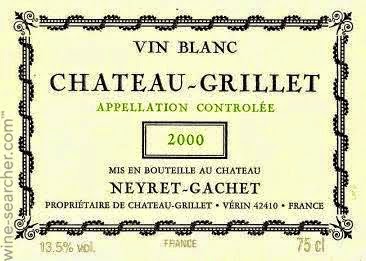Château Grillet:
Rare Bliss Shared by Thomas Jefferson
Rare Bliss Shared by Thomas Jefferson
By Don Merlot
[WritersClearinghouse News Service]
New Orleans
Château Grillet from the Rhone Valley in France is a fascinating white wine. Wine lovers may or may not ever taste this wine, because its availability is so scarce. In 1991 it attained its present size of 9.4 acres along the Rhone River, and it produces up to 10,000 bottles of wine a year. When it first became recognized as an elite wine it was one of three of the smallest foot prints of a premium French wine obtaining an appellation contrôlée status for the property. A few properties in Burgundy are smaller and have the AOC status: such as La Romanée Conti.
Coming south out of Vienne on the road into Rhone’s Northern section, the highly prized Rhone wine names pop out like a constellation in the sky: Côte Rôtie, Condrieu Château Grillet, and St. Joseph. The red wines come from the varietal Syrah and the white wines from Condrieu, and Château Grillet are white wines that come from the Viognier grape. In the 19th century as it wafted its great heights of the great white wines of the world, this wine had become among an elite white wines: It enjoys a lofty status and was found in the cellars of kings and the European wine consuming aristocracy. The name “Grillet” may refer to hillsides “grilled,” or burnt by the sun.
Because Condrieu and Ch. Grillet are vinified with the Viognier varietal does not mean that they are the same level or stature, even though they are neighbors – the French concept of terroir (vin). The varietal is high in alcohol, full body and bouquet, dry in flavor; it is peachy, apricotty, and carries a soft texture.
The history of Viognier tells us the vines came from Dalmatia during Roman Emperor Probus reign in the 3rd century AD. By the middle Ages the wine was highly respected in the Rhone valley, but travel to Paris to get the recognition the owner saught was hampered by the in transit high taxes issued by localities along ground route. Alternate travel to Paris was found using the Loire River valley. In the late 18th century, Thomas Jefferson, while living in France, found it and loved it he took samplings back to Virginia. It even reached Napoleon’s court. It was recognized by the savants of gastronomy as a great white wine equal to other prestigious growths: Montrachet, Coulée de Serrant, Château Yquem and Château Chalon.
Until 2011 the Neyret-Gachet family owned the property. Today it is owned and managed, when the property was acquired in June 2011, by François Pinault, also owner of Château Latour in Pauillac and Domaine d’Eugénie in Vosne-Romanée in Burgundy.
A major difference between Condrieu and Ch. Grillet is that Condrieu when released does not have a long shelf life and will deteriorate quickly after three years. However The Ch Grillet improves with ageing. Condrieu wine should be consumed in its first three to six years; It fades very quickly As for Ch Grillet, it is aged in oak barrels for twenty-four months before it is bottled. It should mature in the bottle at least six years before consumed. Yet it will mature up to ten years. There is no major change in the wine beyond that period.
After the Second World War, France was the epicenter of fine food and wine. The food of Lyon was the gastronomic nirvana of the world. The red Rhone wines rivaled the Burgundy and Bordeaux ranked wines. The finest restaurants in France, according to the Michelin rating system, carried Chateau Grillet. The famous Pyramid restaurant of the Le Point family was considered the epitome of French Fine Cuisine. Every ranked restaurant carried in its cellar Ch Grillet.
Condrieu is dear, but not as dear as Grillet. In the last twenty years, the wine and food culture of France has reached its zenith: Viognier moved out of the Rhone into other AOCs. The varietal grape in Rhone did not have a high yield, and sickly, but oenologists genetically improved it and planted it in new vineyards. It has traveled to the Northwest of the United States and to South America, South Africa, and Oceania.
In the Pantheon of White wine, it has a following, but none have surpassed the Chateau Grillet or Condrieu reputation. They are priced well. There was a period that the Rhone Viognier was headed to oblivion, but Washington State in the USA rekindled the demand in the 80s.
It is a favorite with freshwater fish. Its full body also makes it a favorite with light cheese. It has been offered as an alternate to Chardonnay. In the USA, in metropolitan gourmet scenes and in wine bars, it is gaining popularity.
One should experience Viognier. Perhaps in a restaurant setting where wine is offered by the glass. It is an experience one should not pass up.
